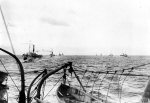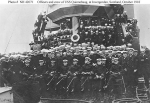Click on thumbnail
for full size image |
Size |
Image Description |
Source |
| SS Jefferson |
 |
47k |
SS Jefferson photographed prior to World War I
U.S. Navy photo NH 42456 |
Naval Historical Center |
 |
184k |
Post card postmarked Norfolk, VA, 6 October 1909 |
Tommy Trampp |
 |
88k |
Photographed circa 1917
Naval Historical Center photo NH 105603 |
Robert Hurst |
| USS Quinnebaug (ID 1687) |
 |
140k |
Painted in "dazzle" camouflage, 1918
Courtesy of Donald M. McPherson, 1969
U.S. Navy photo NH 67875 |
Original photo: Naval Historical Center
Replacement photo: Jim Kurrasch, Battleship Iowa, Pacific Battleship Center |
 |
74k |
U.S. Navy minelayers steaming in column in the North Sea, September 1918. At left, British destroyers are covering the formation's flank with a smoke screen. Ships in the minelayer column are (from front to rear): Roanoke, Housatonic, Quinnebaug and Baltimore
U.S. Navy photo NH 2805 |
Naval Historical Center |
 |
71k |
U.S. Navy minelayers proceeding to sea in two columns, in Area Number 2 of the North Sea, September 1918. Ships in the column at left are (from front to rear): Roanoke, Housatonic, Quinnebaug and Baltimore. Ships in column at right are (from front to rear): Canonicus (out of picture, to right), Canandaigua, Aroostook and Saranac. Note disruptive "dazzle" camouflage worn by these ships
Photograph from the Army Signal Corps Collection in the National Archives
U. S. Army Signal Corps photo 111-SC-43563 |
 |
111k |
American minelayers underway on 20 September 1918. They include; on the right: USS Roanoke (ID-1695), USS Housatonic (ID-1697), USS Quinnebaug (ID-1687), USS Baltimore (CM-1). On the left: USS Canonicus (ID-1696), USS Canandaigua (ID-1694), USS Aroostook (CM-3), USS Saranac (ID-1702)
Imperial War Museum photo No.© IWM(Q 20254) from American First World War Official Exchange Collection
| Mike Green |
 |
182k |
Quinnebaug's officers and crew pose on her foredeck, at Invergordon, Scotland, October 1918. Quinnebaug was then engaged in laying a barrage of anti-submarine mines across the North Sea. Note the "T.N.T." banner at the left end of the bridge, alluding to the mines' explosive charge material
Naval History and Heritage Command photo NH 42071 |
Robert Hurst |
 |
103k |
Photographed circa 1919 by O. W. Waterman, Hampton, Virginia
Naval History and Heritage Command photo NH 98371 |
 |
223k |
c. 1919
Hampton, VA
Engineer's Division photo
Photo by O. W. Waterman from the Vallejo Naval and Historical Museum |
Douglas Davis
Photo added 25 June 2021 |
 |
271k |
Original photo: Photo from the 24 January 1919 edition of the Evening Public Ledger, Philadelphia, PA courtesy of Penn State University Libraries, University Park, PA
Replacement photo: c. 1919
Hampton, VA
Crew photo
Photo by O. W. Waterman from the Vallejo Naval and Historical Museum |
Original photo: Mike Mohl
Replacement photo: Douglas Davis
Replacement photo added 25 June 2021 |
 |
172k |
Photo from the 30 January 1919 edition of the Evening Public Ledger, Philadelphia, PA |
Mike Mohl |











